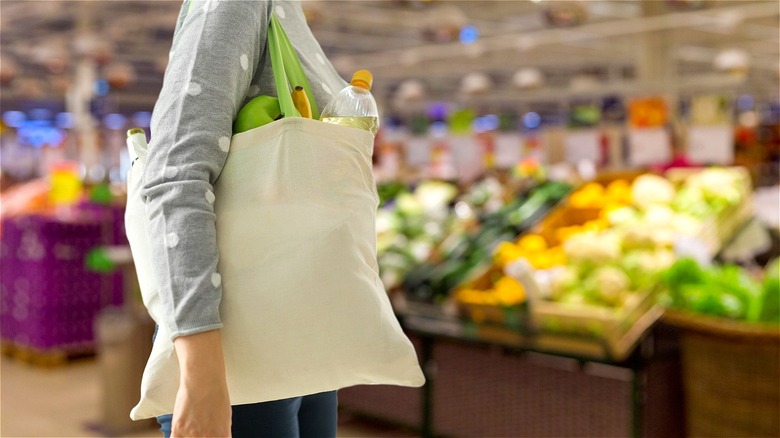The Logical Reason You Should Only Shop At One Grocery Store At A Time
Who enjoys spending an exorbitant amount on groceries? Procuring sustenance week after week can feel monotonous, tedious, and even stressful if you have to shop within the confines of a tight budget. Whether you're buying food at a grocery store or supermarket, most Americans' are privy to the increase in grocery costs. According to the U.S. Inflation Calculator which shows the year-over-year inflationary increase in food costs since 1968, food prices have increased by an average of 1.9% from 2012 to 2021 alone. In 2012, the average cost of one gallon of whole milk cost $3.49 (via U.S. Inflation Calculator). Fast forward to November 2022, and the USDA retail milk prices report indicates the average cost of a gallon costs $4.41.
With the constant price adjustments, consumers are always on the hunt to get the best value for their money, and surprisingly, there are cost discrepancies depending on where you shop. The Consumers' Checkbook 2022 survey found that chains like Aldi and Lidl could save you up to 50% on weekly food costs, yet their analysis indicates a slight lack of food quality. Is it smart to get the basics at Aldi and go for produce at a certified organic grocer like Whole Foods? Based on current research, you should always stick to one store at a time, and here's why.
If you shop at several stores, you'll probably spend more money
According to Intuit Mint Life, the average dollar amount spent on groceries per month averages between $150 to $300. Of course, here are some great grocery shopping secrets you can keep in your back pocket to minimize spending. While multiple shopping trips per week may help keep your pantry stocked, in the end, you'll have less money and less gas in your vehicle. Extension field specialist from South Dakota State University, Dr. Saboe-Wounded-Head believes the extra time and money spent at different stores could just end up costing you more in the long run (via The Kitchn).
Based on findings from a 2022 survey by Slickdeals via OnePoll, 73% of Americans admitted to spending more on impulse buys. In fact, food and groceries accounted for 30% of impulse purchases in 2022 and 48% in 2021. What better way to entice your urge to spend than by visiting a one-off food store mid-week? Beyond the extra dough you might shed, grocery shopping takes time. Survey results from Driveresearch indicate 64% of consumers spend at least 30 minutes on average for every grocery visit and those precious minutes don't even account for travel time. The odds are stacking up against the prospect of multiple supermarket visits, but avoiding several stores in one week is not the only way to become a smarter food shopper.
Other ways to save money and time when grocery shopping
If you feel like you don't know how to save money at the grocery store, there are a few simple steps you can take ahead of time to ensure you're doing everything in your power to be as efficient as possible. GoBankingRates advises consumers always to have a written plan before shopping. Not only does this decrease your chances of impulse buying, but the simple process of sifting through your pantry and writing out exactly what you need for the week may encourage you to read the weekly ads and sales offered by your supermarket. To minimize the frequency of your grocery trips, Mental Floss suggests incorporating pantry items you already have into next week's meals and opting to create more basic recipes that can be adaptable based on the ingredients you have on hand.
Escaping The Bench encourages consumers to consider more dried and frozen produce to stretch their weekly hauls. For general cost-effectiveness, GoBankingrates stresses the importance of participating in a grocer's rewards program, reading about up-and-coming sales for the week, and actually grabbing those free products when you buy items included in buy-one-get-one promotional deals. Food Network also advises looking beyond the products stacked on shelves directly at your eye level. Sometimes the most affordable products are located on the tops and bottoms of shelves. All in all, there's more than one way to be an efficient food shopper.


